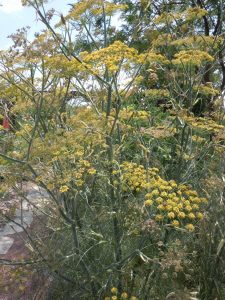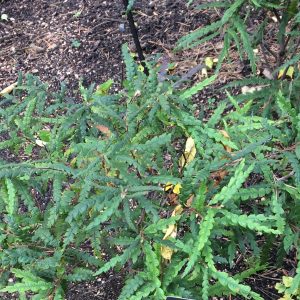Search Results for: Agastache foeniculum Anise hyssop
-
Foeniculum vulgaris ‘Purpureum’ Bronze fennel Z 4-9
OUT OF STOCK Yellow blooms on flat-topped umbels in late spring into summer, features dusky purple, feathery, compound, aromatic purple leaves with needle-like segments....
OUT OF STOCK
Yellow blooms on flat-topped umbels in late spring into summer, features dusky purple, feathery, compound, aromatic purple leaves with needle-like segments.
Size: 4-5’ x 2-3’
Care: sun to part shade in well-drained soil. Drought tolerant.
Native: Mediterranean
Wildlife Value: attracts bees and birds. Nectar plant for Swallowtail butterflies. Flat-topped surface gives insects a landing pad.Ancient Egyptians used fennel as food and medicine. Considered a snake bite remedy in ancient China. During the Middle Ages it was hung over doorways to drive away evil spirits. Fennel is also associated with the origin of the marathon. Athenian Pheidippides carried a fennel stalk on his 150-mile, 2-day run to Sparta to gather soldiers for the battle of Marathon with Persia in 490 B.C. The battle itself was also reportedly waged on a field of fennel. The Gardeners Dictionary, eighth ed. 1768.
-
Agastache aurantiaca Navajo sunset Z 5-9
ARCHIVED Note: This is a plant not currently for sale. This is an archive page preserved for informational use. Brilliant light orange blooms from spring-fall, silvery-grey aromatic foliage...
ARCHIVED
Note: This is a plant not currently for sale. This is an archive page preserved for informational use.
Brilliant light orange blooms from spring-fall, silvery-grey aromatic foliage
Size: 12-18” x 24”
Care: sun in well-drained soil
Native: Western US
Wildlife Value: attracts bees, butterflies, hummingbirds, and birds. Deer and rabbit resistantPublished in American Midland Naturalist 1945.
-
Comptonia peregrina Sweet Fern Z 2-6 SHRUB
Grown for its fern like leaves, this small shrub flowers in spring with insignificant yellow flowers followed by brown nutlets. Foliage is fragrant when crushed. LIMITED QUANTITES AVAILABLE. ONE PER...
Grown for its fern like leaves, this small shrub flowers in spring with insignificant yellow flowers followed by brown nutlets. Foliage is fragrant when crushed.
LIMITED QUANTITES AVAILABLE. ONE PER CUSTOMER PLEASE.
Size: 2-5’ x 4’ spreading
Care: sun to part shade in moist, well-drained to well-drained soil. Prefers acidic, but will grow in other types of soil as well. Drought and salt tolerant.
Native: Eastern North America, Wisconsin native
Wildlife Value: Attracts bees, butterflies, & birds. Larval host plant for many moths, including Io moth, several Sphinx moth species, and the Anise Swallowtail butterfly. Deer resistant. Nitrogen fixer.Genus name honors Henry Compton (1632-1713), Bishop of London and patron of botany. Many Native Americans (Algonquin, Cherokee, Chippewa, Delaware, Menominee, Potawatomi) used this plant for a wide variety of purposes: crushed leaves inhaled for headache. Leaf infusions for round worms, fevers, beverage, blood purifier, blisters, clear mucus from lungs, bladder inflammation, rash from poison ivy, swelling, flux, stomach cramps, itch. Fragrant leaves- burned or crushed for incense in ceremony, perfume; decoction for childbirth, tonic. Other: sprinkle on medicine to poison enemy, prevent blueberries from spoiling, leaves in fire to make smudge to ward off mosquitoes. Oneida made a tea.
Collected for botany before 1753. Grown at America’s 1st botanic garden, Elgin Botanic Garden 1811.**LISTED AS OUT OF STOCK BECAUSE WE DO NOT SHIP THIS ITEM. IT IS AVAILABLE FOR PURCHASE AT OUR RETAIL LOCATION.



